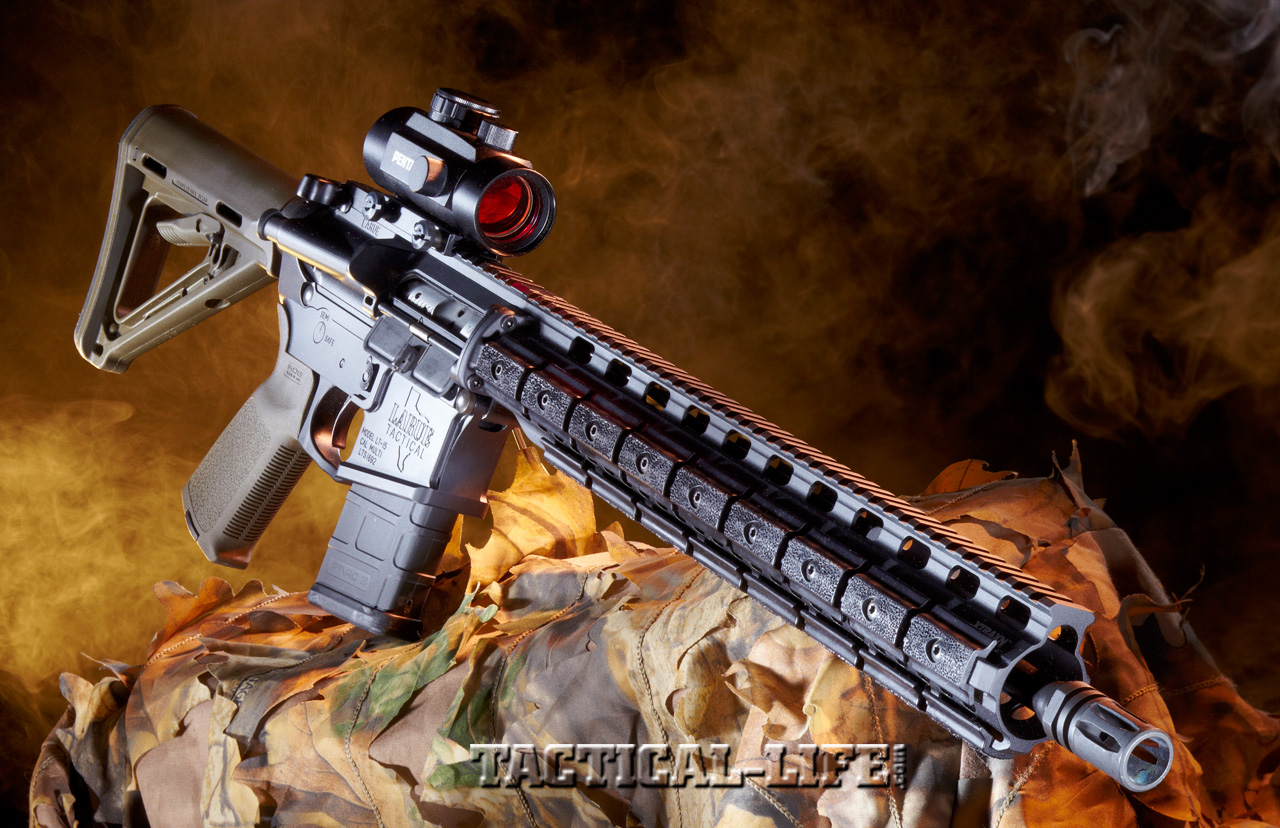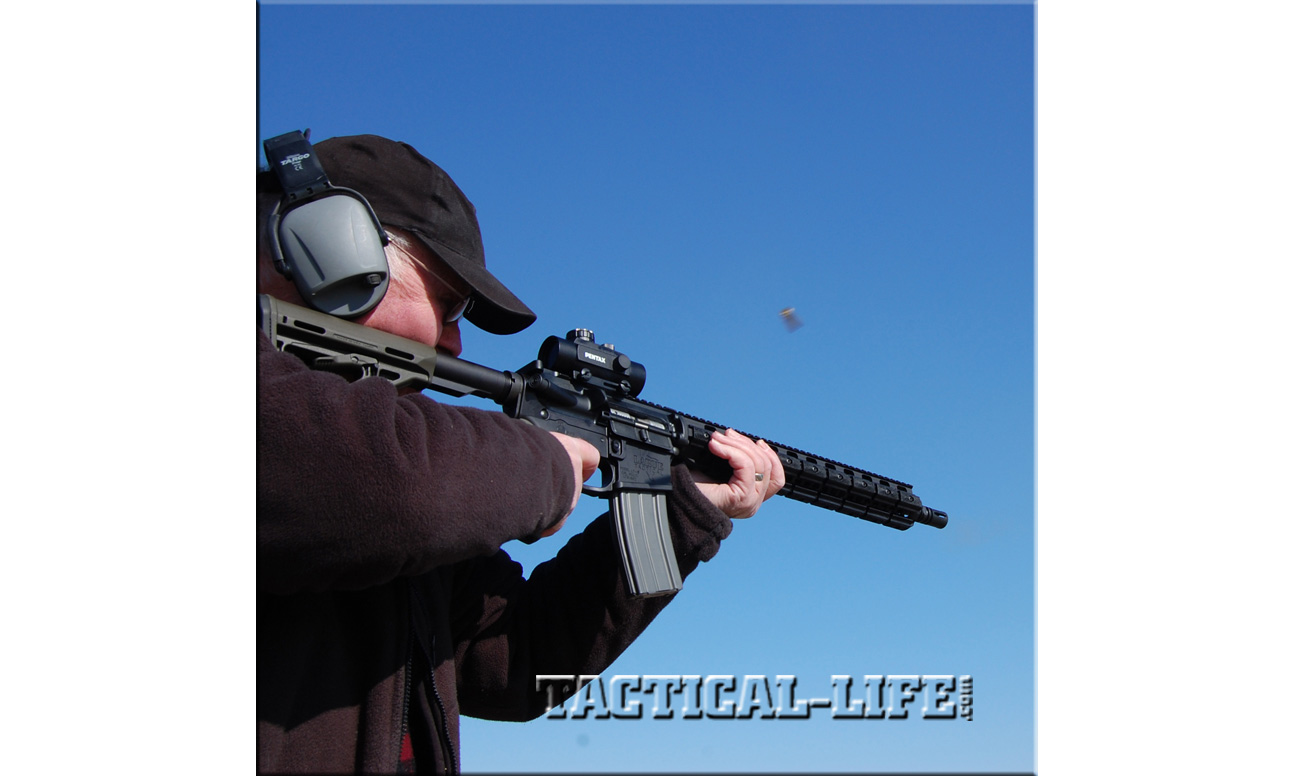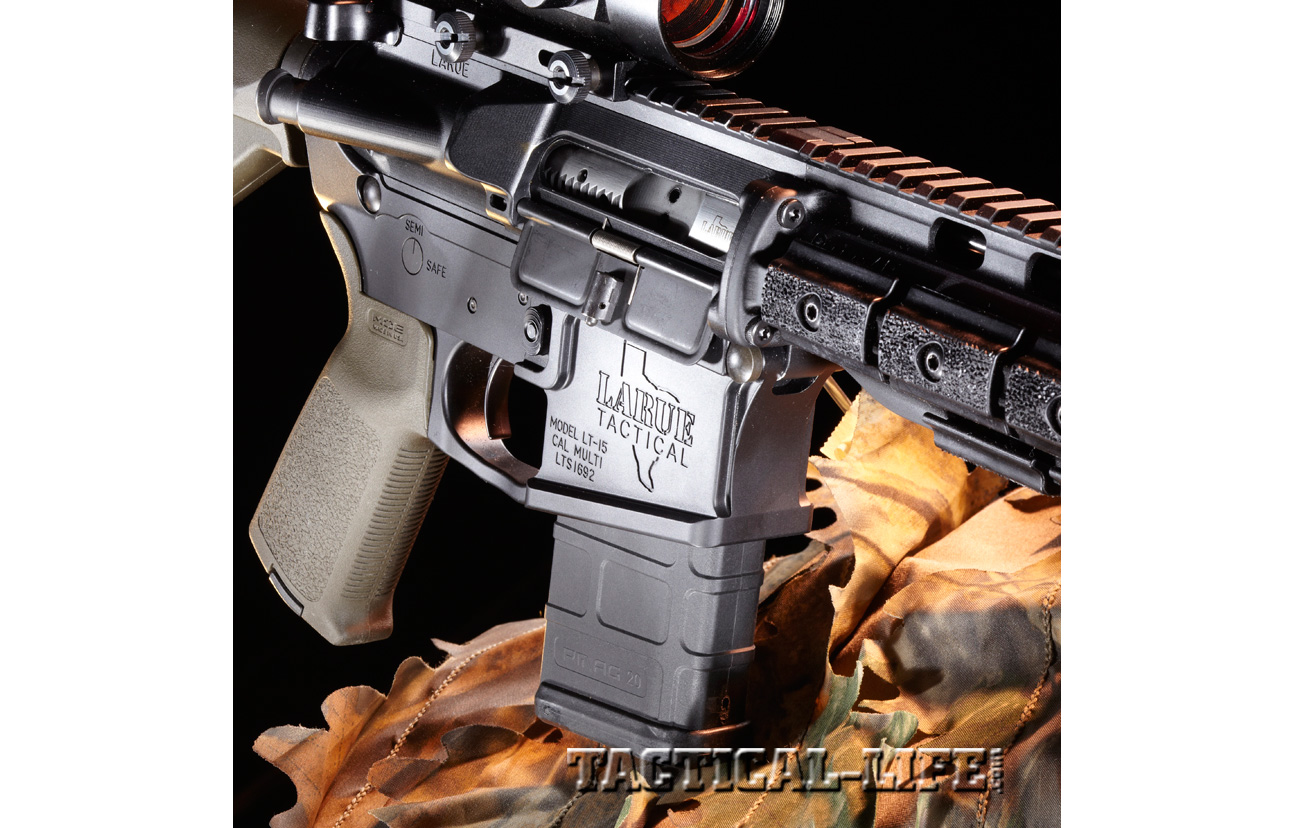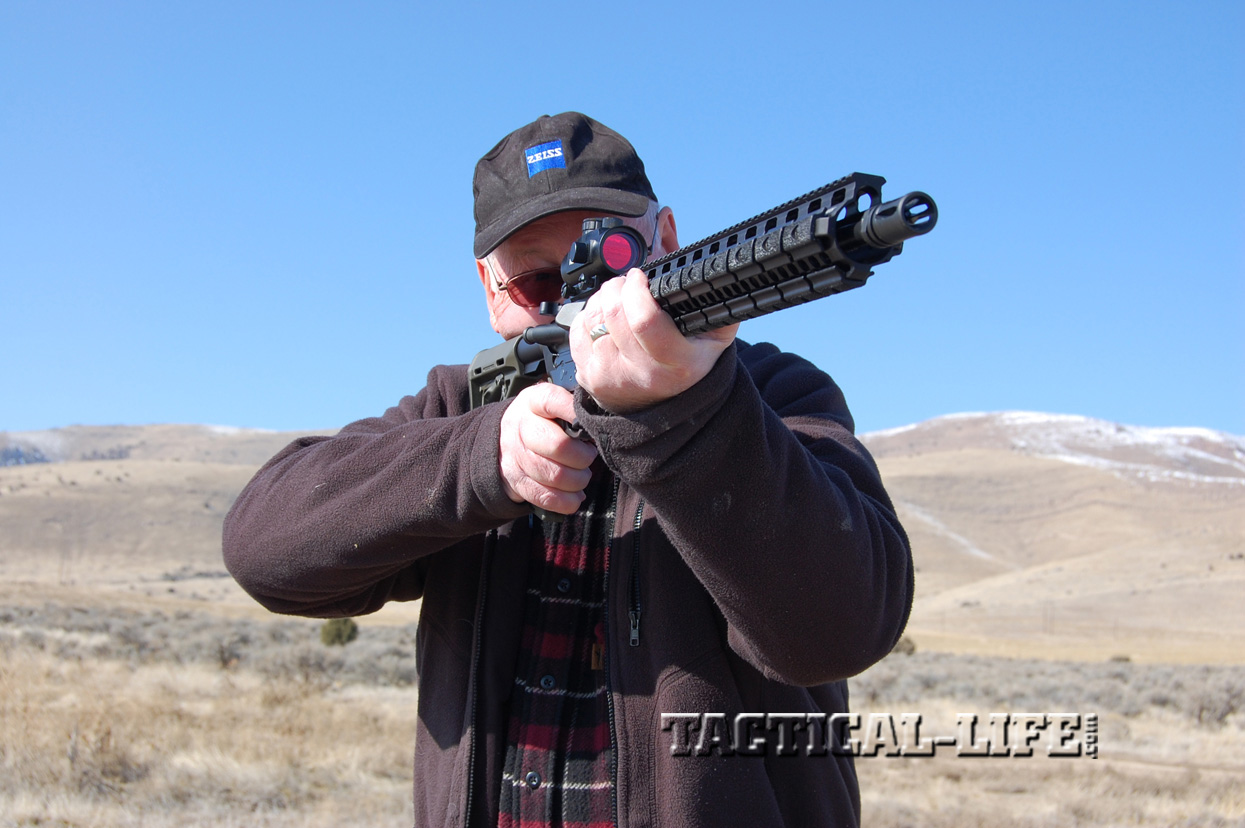AR-15 clones are legion. It seems like everywhere you look, you see yet another semi-automatic rifle featuring the basic platform that has served our troops well for so many years. While these rifles were originally designed for military use, sportsmen and law enforcement agencies have flocked to buy them. I wouldn’t even try to guess how many manufacturers are currently producing these amazingly popular rifles in 5.56mm and 7.62mm NATO chamberings.
I’ve tested a number of these “black rifles,” sometimes with mixed results. Inevitably, some are better made than others, and deliver varying reliability. LaRue Tactical has been manufacturing 1911 slides, mounts and more for several years. The company’s AR-style rifles are very well designed and manufactured to tight specifications (so tight I first had trouble separating the upper and lower assemblies of the rifle I was sent for testing).
Light Weight, Big Bite
The 5.56mm LaRue Tactical PredatAR rifle I’ve been using tips the scales at just 6.25 pounds empty—2 pounds lighter than most rifles built on the Stoner design. Lighter weight means markedly improved carrying and far better handling capabilities than heavier AR-15s offer. Additional heft comes in handy for minimizing full-auto recoil. Because the Predat- AR fires only one shot each time you pull the trigger, there’s no need to compensate for fully automatic operation. For the record, recoil from the PredatAR 5.56mm is barely noticeable. The 5.56mm rounds it digests are easy on the shoulder, even in a 6.25-pound rifle.
Advertisement — Continue Reading Below
According to LaRue, “the PredatAR takes the highly accurate OBR (Optimized Battle Rifle) 5.56mm ‘Lite’ design, and lightens it in every possible way. The trick is to do that with the least possible impact to the accuracy that the standard OBR is known for. By contouring the barrel, skeletonizing the handguard, lowering and simplifying the upper rail, and using a low-profile gas block, we were able to reduce roughly 2 pounds from the standard OBR 5.56 rifle.”
The handguard has an unusual appearance. At first glance, it resembles a familiar quad-rail forend, but only the upper rail is a Picatinny design that allows for quick mounting of optical day or night sights. The upper rail has a 0-MOA slope, allowing you to correctly position whatever sight you mount. The sides and bottom feature a series of close-mounted, removable blocks that provide an excellent grip for the shooter. Users can replace the blocks with rail sections for add-ons.
The PredatAR’s handguard assembly measures just 7 inches in circumference. This streamlined assembly is slimmer than similar forends on the market. It mounts directly to the upper receiver and contacts neither the barrel nor barrel nut, providing a true free-floating barrel for maximum accuracy. Each rifle comes with one 3-inch, detachable Picatinny rail section to add to the handguard.
Advertisement — Continue Reading Below
The rifle’s upper and lower assemblies are CNC-machined from single billets of 7075-T6 aluminum. This ensures a tight fit and greater consistency. Like the vast majority of AR-15 rifles on the market, the PredatAR sports both an ejection port cover and a forward assist plunger. I’ve never been a big fan of the forward assist feature, and the ejection port cover is more useful in battle than in hunting situations. But if you’re going to have an AR-type rifle, you may as well include these touches.
The barrel is made of stainless steel and has a lightweight profile. LW-50 stainless has been thoroughly proven in military and civilian service, particularly in sniper and other applications where long life and accuracy are critical. The barrel incorporates a Wylde chamber and polygonal rifling with a 1-in-8-inch twist rate. The barrel is also threaded and comes with an A2-style flash suppressor attached. The bolt and bolt carrier are polished and chrome-plated for slick, dependable operation. The lower assembly features an excellent Geissele Two-Stage trigger.
The PredatAR features a six-position Magpul MOE stock and pistol grip finished in olive drab. In case you didn’t know this, rifles featuring flash suppressors, bayonet lugs, collapsible stocks and high-capacity magazines are subject to regulation in certain states, counties and cities. This is something worth checking before you try purchasing one of the new PredatAR rifles. It’s best to be sure all the bells and whistles you’re getting are legal in your area.
Advertisement — Continue Reading Below
I mounted a Pentax Precision Plex Gameseeker red-dot scope on the rifle’s Picatinny rail, but that added only a few extra ounces. This scope provides no magnification, which means you can keep both eyes open for immediate target acquisition. That makes it ideal for hunting jackrabbits and other fast-moving targets. The red-dot reticle intensity can be changed to suit ambient light conditions. The lack of image magnification is actually a plus—not a handicap—for most hunting situations. So far, this rifle and scope combination has accounted for a number of prairie dogs at ranges exceeding 200 yards. I’m looking forward to hunting coyotes with this rig in the not-too-distant future.
Desert Fire
I was already impressed with this rifle, but it remained to be seen what kind of accuracy it would deliver. I gathered up an assortment of factory ammo, placed my portable shooting bench in the car, and headed for my desert range. This is actually a large chunk of sagebrush desert some 40 miles from my home. I have an excellent municipal shooting range a short drive away, but it’s often too crowded for my taste. Shooters who don’t want to wait while a rangemaster calls “cease fire” before venturing downrange to retrieve their targets have used the uninhabited desert to good advantage. I typically share the desert range with three or four other shooters, but it’s a big desert. Shooters are usually separated by a mile or two of sagebrush, so we don’t get in each other’s way.
As a bonus, there’s often a jackrabbit or two bounding by, providing a moving target. After testing a rifle for accuracy, I sometimes spend an extra couple of hours hunting the long-eared speedsters. As long as I’ve made the hour-long trip to desert country, it only makes sense to try my hand at hunting jacks. There are coyotes in the area, but hunting them at midday, after firing a few hundred rounds at targets, is generally unproductive.
Advertisement — Continue Reading Below
Once I’d set up my bench and placed targets at the 100-yard mark, I got down to work. In the process, I quickly came to appreciate the rifle’s excellent Geissele trigger. While this is technically a two-stage trigger, the first “take-up” stage offered very little resistance. The second stage broke cleanly and crisply at 4.25 pounds. I could have sworn it was actually lighter.
In addition to the paper sack full of mixed rounds I used to gauge reliability, I had also brought three different factory loads along for the accuracy test. They included Black Hills ammo loaded with 77-grain Sierra MatchKing bullets, Remington ammo throwing 55-grain Pointed Soft Point (PSP) bullets, and CorBon ammo loaded with 62-grain DPX bullets. All were .223 loads—no 5.56mm NATO ammunition was used.
The PredatAR’s accuracy was excellent. The Remington ammo just exceeded the 1-MOA mark, while Black Hills’ 77-grain MatchKing load posted the best accuracy. Three-shot groups measured 0.63 inches between centers. That’s exceptional performance from a 6.25-pound AR rifle. Test-firing was done from a lightweight bench, with sandbags used for support. I intend to add a telescoping bipod to make the rifle more convenient for use in prairie dog towns. I’ll also likely switch out the red dot for a conventional 10X riflescope—the extra magnification for extended shots at distant prairie poodles will be put to good use.
Advertisement — Continue Reading Below
I burned through some 350 rounds of commercial ammunition while I was at the range. As I said earlier, recoil was not a problem, even toward the end of testing, thanks in part to the gas-operated action. The PredatAR performed flawlessly, feeding and firing everything I fed it without a hitch. LaRue rates the barrel life at 10,000 rounds. At the rate dedicated AR fans burn through ammo, the original barrel may last only a few short years. Bolt-action rifles typically give longer service because of their substantially lower rate of fire.
After testing the PredatAR, I couldn’t find a lot to complain about the new rifle. It fed and functioned just fine and exhibited a more-than-acceptable level of accuracy. I’m particularly fond of the rifle’s easy-carrying heft. As its name implies, this is an AR designed for hunting predators. Some legwork is usually required when hunting prairie dogs, and an 8- or 9-pound rifle is a real disadvantage here. For more information, visit laruetactical.com or call 512-259-1585.


































